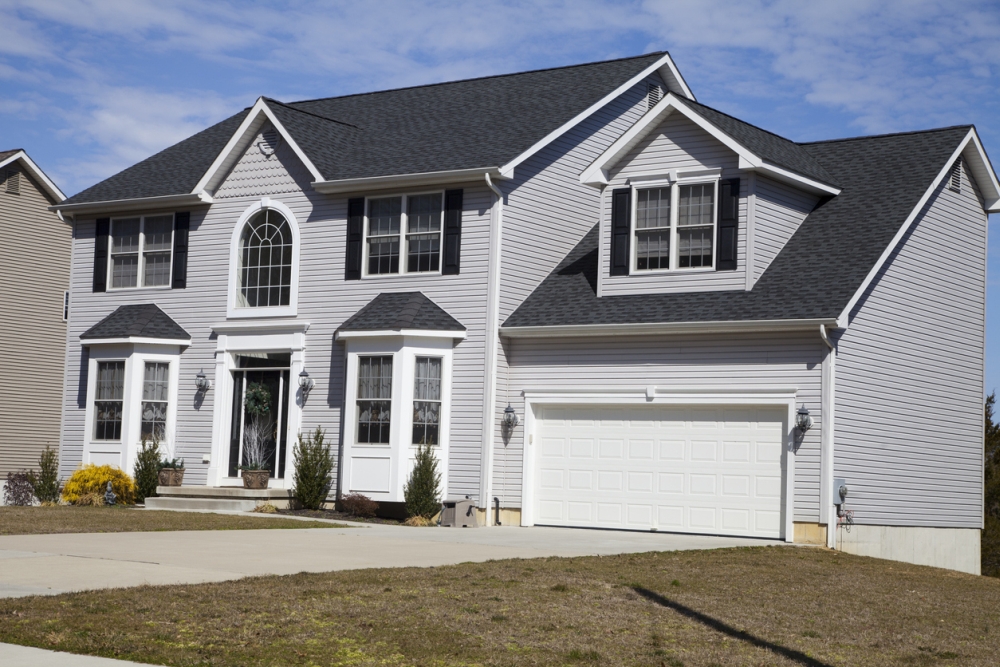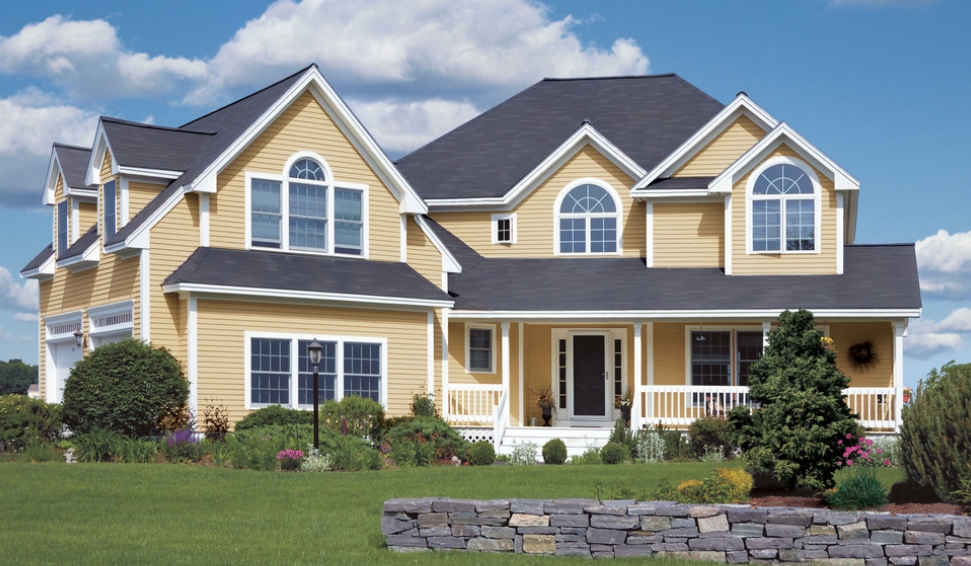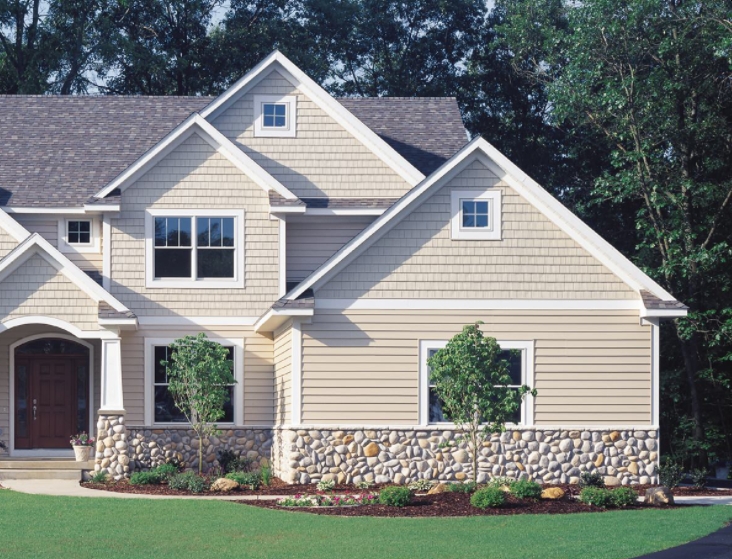How Much to Install Vinyl Siding Per Square
Vinyl siding is one of the most popular types of siding. It is affordable and looks good, but often gets a bad name. Why is this? Well, anything affordable is often looked over in favor of expensive options.
 View in gallery
View in gallery
Anyone should be able to choose any siding. If vinyl is something that intrigues you, then go for it! If you aren't interested in it, then choose something else. For those who are interested, here's what you need to know.
What Is Vinyl Siding?
Vinyl siding is a plastic siding usually made primarily out of polyvinyl chloride (PVC) resin. The siding is an extremely popular option for all types of homes due to its price and versatility as home siding.
But before hopping on the wagon and choosing whether you want vinyl siding or not, it's important to learn all that you can about it. Starting with pros and cons and ending with some FAQs, let's learn about vinyl siding.
Pros And Cons Of Vinyl Siding
Every type of siding has its own pros and cons. So let's quickly go over the pros and cons of vinyl siding. This may be enough to help you make your decision or it could leave you wanting even more info.
Pros Of Vinyl Siding
- Cost
- Versatility
- Rarely Needs To Be Painted
- Surprisingly Low-Maintenance
- Easily Replaced
- Water-Resistant
Cons Of Vinyl Siding
- Difficult To Install Properly
- Can Look Cheap
- Can't Be Authentic
- Not Extremely Durable
- Doesn't Add Value
- Moisture Problem
Types Of Vinyl Siding
 View in gallery
View in gallery Not all vinyl siding is the same. There is vinyl siding for any type of house, any style of decor, and any budget. Let's take a deeper look into the different types of vinyl that can help you make your decision.
Dutch Lap
 View in gallery
View in gallery Dutch lap is one of the most popular types of siding. It is the simple ridged siding that is horizontal. Lap siding, in general, is popular but this is readily available and is still affordable while looking high-end.
Clapboard
 View in gallery
View in gallery Clapboard is a close cousin to dutch lap. The difference is that with clapboard, each board is separated, or at least looks that way. But dutch lap is more connected and smoother, with rounded edges.
Beaded
Beaded siding is siding that looks just like a dutch lap but has a line on the bottom of each lap. This gives a unique, high-end look with very little effort. The beading looks nice and can even be painted separately.
Shingles
 View in gallery
View in gallery Shingles are common in almost any type of siding, from clay to wood. But they are also popular with vinyl. This is more common with roofs than siding but can look adorable on any home with vinyl siding.
Log/Wood
 View in gallery
View in gallery You can actually get vinyl siding that imitates either logs or simple wood, such as shiplap. The log vinyl is often the most expensive but also looks the most impressive. It is still much cheaper than logs.
Board And Batten
Board and batten is a common style that can work with any design style. It is a flat siding that is broken up with thin, usually one-inch boards. This is a unique style that can make your home stand out.
Shake
 View in gallery
View in gallery Shake-style siding is a very old style. It looks rustic to most people which can be such a good thing. It is very similar to shingles but the pieces are uneven and look aged. This is a highly sought-after look for many.
Scalloped
Scalloped siding is a type of siding that is similar to shingles or clapboard and can come in either variation. However, each end is scalloped like scales with round edges or half-circles. This is a smooth and soft look.
Vertical
Vertical vinyl siding is actually quite rare. While it is different to install, it can really make your house stand out and look taller. There are usually grooves and the look is very clean, much more so than horizontal options.
Best Vinyl Siding
There isn't exactly a best vinyl siding, but there are some good options as far as brands are concerned. There we have brands that you can almost always feel safe choosing, so look for brands like these.
- CertainTeed
- Mastic
- Royal
- Georgia Pacific
- Norandex
- Kaycan
- Owens Corning
- Novik
- Homeside
How To Install Vinyl Siding
Installing vinyl siding may take some practice. The exact type of siding affects the installation process, but today, we will go over the most common way to install vinyl siding as most of them are found in panels.
 View in gallery
View in gallery
Step 1: Create A Chalk Reel Line
Find the lowest corner of the side of the house and string the reel along the bottom. Snap it in place once you have it placed, using a level to ensure that it is indeed straight. The last thing you want is crooked siding.
So don't skip this step. You can have a helping hand hold the level and another hold the end of the line. Or wrap the line around nails that you have placed that can help do the same job if you are alone.
Step 2: Install Starter Strip
Get the starter strip started by placed it level with the chalk line you just created. Then, secure it into place with nails. If this proves difficult, you probably need to even your wall out before you begin.
Do this by shimming the low parts up and either sanding or nailing the high parts down. Then you can install your starter strip that will help you ensure everything is straight and secure, leaving a quarter-inch gap for expansion.
Step 3: Install Corner Posts And Splice
Install vinyl inside corner posts 3/4 inch below the bottom of the starter strip. Set them and nail them to the adjoining walls. Do the same for the outside corner posts, allowing a 1/4 gap near the eaves.
If more than one length of corner post is needed, then make a splice by cutting one inch off of all of them except the outer one that will show. Cut less if you feel that would be too much, and never cut too much.
Step 4: Install Siding Trim Around Windows
 View in gallery
View in gallery
Install an exterior siding trim around all windows and doors. This will help brace and insulate the windows and the siding. Never skip any step that is related to insulation or support or you will regret it later.
Step 5: Install First Piece
After everything is ready, it's time to install the first piece. Snap the bottom of the panel into a starter strip and nail it to the wall. It's usually best to start at the back of the house for symmetry and to leave room for mistakes.
Step 6: Begin Overlap Process
Overlap each panel around an inch. There should be small holes that let you know where this should be. But a good overlap is extremely important. Too much of an overlap is better than too little, so add a 1/4 in if unsure.
Step 7: Fit Under Windows
This is the most difficult part of installing the siding. You will need to cut the siding panels to fit under the windows. To make things look nice, you should try to ensure that there are two pieces that meet under the window.
If you don't do this, the line will look awkward and the small piece underneath won't be as secure, so try to even it up as much as possible.
 View in gallery
View in gallery
Step 8: Snap Lock
Punch the top panel with a snap-lock punch then insert the cut panel into the trim and draw a line where they meet. Then punch the panel on top of this line every 6 inches. This is so that the raised part is on the outside of the panel.
Step 9: Finish Up
After you finish, go over the entire thing and ensure that everything matches up and is secured tightly. You may have to add a few more nails or lock a few more pieces that weren't secure. Then you're done.
Vinyl Siding FAQs
There are many questions that people ask about vinyl siding. Hopefully, yours will all be answered right here.
Can You Paint Vinyl Siding?
Yes, you can. Some people like to paint their siding every few years. But you don't have to as the pigments used to color the siding run deep. This doesn't stop it from fading, of course, so paint whenever you feel it needs to be refreshed.
How Much Does Vinyl Siding Cost?
Vinyl siding is not expensive. This is why it's so popular. Most siding like this won't cost more than $10,000 fr the entire project. The cost per square foot is around $5, with a large range for labor and brands.
How Long Does Vinyl Siding Last?
Vinyl siding can last a lifetime if it is taken care of and in a mild climate. But in general, it needs to be replaced about every 30 years or so. This is plenty of time to decide what to do next anyway and can be exciting.
Can You Remove Vinyl Siding?
Yes, you can. You will need to have something on hand that can cut the siding and something to remove the nails. Other than that, you should be good to go unless you used adhesive to install the vinyl.
How Do You Clean Vinyl Siding?
Vinyl siding can be cleaned with dish soap and water. There are other ways to do so but this is definitely the cheapest way that is still effective. For other ways, use a commercial cleaner for your siding.
How Do You Allow For Expansion And Contraction?
You can do this by angling your nails instead of nailing them in straight. This is a simple technique that is secure yet allows for any expansion or contraction that the siding might go through over the seasons and years.
How Much to Install Vinyl Siding Per Square
Source: https://www.homedit.com/vinyl-siding/